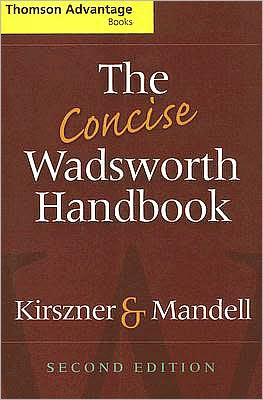Cengage Advantage Books: The Concise Wadsworth Handbook
Tailored to student learning styles and needs, grounded in student models, and used as a resource for all academic and workplace contexts, THE CONCISE WADSWORTH HANDBOOK, SECOND EDITION, offers practical writing advice for today's student-emphasizing the writing and research processes in a brief, affordable, spiral-bound format. THE CONCISE WADSWORTH HANDBOOK, SECOND EDITION, is THE complete reference for the college writer. Student and instructor friendly, easy to use, and offering more...
Search in google:
Tailored to the way students like you study and learn, this handbook is THE go-to-guide for every kind of writing-in and out of the classroom. With practical advice on topics ranging from writing effective essays, paragraphs, and sentences to documenting sources and designing Web pages, THE CONCISE WADSWORTH HANDBOOK is the essential tool for any college student. The handbook's numerous features-including checklists, "Close-up" boxes, computer tips, "Grammar Checker" boxes, and marginal cross-references-are
How to Use This Book. Introduction: Ten Habits of Successful Students. PART 1: WRITING ESSAYS. 1. Understanding Purpose and Audience. 2. Planning an Essay. 3. Using a Thesis to Shape Your Material. 4. Drafting and Revising. 5. Writing Paragraphs. 6. Thinking Critically. 7. Writing Argumentative Essays. 8. Writing Essays about Literature. PART 2: DEVELOPING STRATEGIES FOR ACADEMIC SUCCESS. 9. Reading to Write. 10. Writing Essay Exams. 11. Writing for the Workplace. 12. Designing Effective Documents. 13. Designing a Web Site. PART 3: SENTENCE STYLE. 14. Building Sentences. 15. Writing Varied Sentences. 16. Writing Emphatic Sentences. 17. Writing Concise Sentences. 18. Using Parallelism. 19. Choosing Words. PART 4: UNDERSTANDING GRAMMAR. 20. Using the Parts of Speech. 21. Using Nouns and Pronouns. 22. Using Verbs. 23. Using Adjectives and Adverbs. 24. Revising Sentence Fragments. 25. Revising Run-ons. 26. Revising Agreement Errors. 27. Revising Misplaced and Dangling Modifiers. 28. Revising Awkward or Confusing Sentences. PART 5: UNDERSTANDING PUNCTUATION. 29. Using End Punctuation. 30. Using Commas. 31. Using Semicolons. 32. Using Apostrophes. 33. Using Quotation Marks. 34. Using Other Punctuation Marks. PART 6: UNDERSTANDING SPELLING AND MECHANICS. 35. Improving Spelling. 36. Knowing When to Capitalize. 37. Using Italics. 38. Using Hyphens. 39. Using Abbreviations. 40. Using Numbers. PART 7: DOING RESEARCH AND DOCUMENTING SOURCES. 41. Writing a Research Paper. 42. Doing Library and Field Research. 43. Using and Evaluating Internet Sources. 44. Summarizing, Paraphrasing, Quoting, and Synthesizing Sources. 45. Avoiding Plagiarism. 46. MLA Documentation Style. 47. APA Documentation Style. PART 8: BILINGUAL AND ESL WRITERS. 48. Grammar and Style for ESL Writers. Glossary of Usage. Answers to Selected Exercises. Credits. Index. Correction Symbols.








